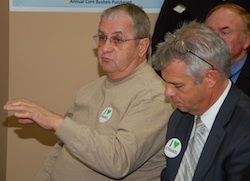 Iowa Senator Mark Jacobs and Sam Clovis who are running for the Congressional seat that is open with Senator Tom Harkin retiring, are both confirmed for the Iowa Renewable Fuels Association’s renewable fuels forum. This free event is open to the public and taking place on Thursday, December 19, 2013 from 2:00 to 4:00 pm CST at the Western Iowa Tech Community College Cherokee Campus Auditorium.
Iowa Senator Mark Jacobs and Sam Clovis who are running for the Congressional seat that is open with Senator Tom Harkin retiring, are both confirmed for the Iowa Renewable Fuels Association’s renewable fuels forum. This free event is open to the public and taking place on Thursday, December 19, 2013 from 2:00 to 4:00 pm CST at the Western Iowa Tech Community College Cherokee Campus Auditorium.- Consumers Energy has selected 31 solar powered projects offered by businesses, homeowners and nonprofit groups across Michigan’s Lower Peninsula to supply renewable energy to customers. The suppliers were chosen as part of the company’s Experimental Advanced Renewable Program (EARP). The program provides for the long-term purchase of renewable energy generated by solar energy systems owned by electric customers.
- Unirac, Inc., a Hilti Group Company and provider of high quality, competitive PV mounting solutions in North America, has been selected by Green Light Plaster City Solar and ZGlobal, Inc. to provide a 1 MW Ground Mount Tracker (GMT) at the United States Gypsum’s (USG) manufacturing facility in Plaster City, CA. The project broke ground late in November and is scheduled to be completed in January 2014.
- E.ON Climate & Renewables North America (EC&R) has announced it has secured institutional equity financing for approximately $96.2 million and a commitment to fund further capital contributions from JPM Capital Corporation (J.P. Morgan) in exchange for a partial interest in EC&R’s Panther Creek I&II Wind Farm (Panther Creek). Panther Creek is part of a billion-plus-dollar investment EC&R has made in the Big Spring, Texas area since 2006. The projects are located in Howard, Sterling and Glasscock Counties, Texas. Panther Creek’s 172 GE 1.5 megawatt turbines generate enough energy to power approximately 77,000 homes.
OSU Spinoff NuScale Goes Nuclear
Oregon State University (OSU) spinoff NuScale Power has been awarded up to $226 million in funding from the U.S. Department of Energy (DOE). The company is developing a new form of nuclear power and is a spinoff company based on the pioneering research of OSU professor Jose Reyes. Today Reyes has become one of the international leaders in the creation of small “modular” nuclear reactors.
According to NuScale, this technology holds enormous promise for developing nuclear power with small reactors that can minimize investment costs, improve safety, be grouped as needed for power demands and produce energy without greenhouse gas emissions. The technology also provides opportunities for OSU nuclear engineering students who are learning about these newest concepts in nuclear power.
 “This is a wonderful reflection of the value that OSU faculty can bring to our global economy,” said Rick Spinrad, vice president for research at OSU. “The research conducted by Professor Reyes, colleagues and students at OSU has been a fundamental component of the innovation at NuScale.”
“This is a wonderful reflection of the value that OSU faculty can bring to our global economy,” said Rick Spinrad, vice president for research at OSU. “The research conducted by Professor Reyes, colleagues and students at OSU has been a fundamental component of the innovation at NuScale.”
NuScale said it is bringing closer to reality a nuclear concept that could revolutionize nuclear energy. The Obama administration has cited nuclear power as one part of its blueprint to rebuild the American economy while helping to address important environmental issues.
“OSU has made a strong effort to build powerful partnerships between our research enterprise and the private sector,” said OSU President Edward J. Ray. “The DOE support for NuScale is a vote of confidence in the strategy of building these meaningful relationships, and they are only going to pick up speed with our newest initiative, the OSU Advantage.”
News of the NuScale grant award was welcomed by members of Oregon’s Congressional delegation. “Oregon State University deserves a lot of credit for helping to develop a promising new technology that the Energy Department clearly thinks holds a lot of potential,” said Sen. Ron Wyden, chairman of the U.S. Senate Energy and Natural Resources Committee. “Today’s award shows that investing in strong public universities leads to innovative technologies to address critical issues, like the need for low-carbon sources of energy, while creating private sector jobs.”
OSU officials say the development of new technologies such as those launched from NuScale could have significant implications for future energy supplies. “The nation’s investment in the research of small-scale nuclear devices is a significant step toward a diverse and secure energy portfolio,” said Sandra Woods, dean of the College of Engineering at OSU. “Collaborative research is actively continuing between engineers and scientists at Oregon State and NuScale, and we’re proud and grateful for the role Oregon State plays in assisting them in developing cleaner and safer ways to produce energy.
A Q&A with JatroDiesel
JatroDiesel’s technology has been selected by Patriot Renewable Fuels for its 4-5 million biodiesel facility under construction next to its ethanol plant in Annawan, Illinois. The biodiesel plant, when it goes into operation in September 2014 will use the corn oil produced during the ethanol process for its primary feedstock. To learn more about the multi-feedstock biodiesel technology, I spoke with Raj Mosali, CEO of Jatro Diesel.
 How did you get into the biodiesel industry?
How did you get into the biodiesel industry?
“I would say it was serendipity,” said Mosali. We wanted to do something in the industry. We began developing the technology in the garage. The first iteration was a bad system that could only use soy. Today, they have developed the technology for a fully continuous plant that produces biodiesel from multi-feedstocks.
What types of technologies did you develop?
We have two types of technologies, answered Mosali. One is traditional (catalysts, acid and methanol) and one is super critical methanol-based technologies that is being used for Patriot’s biodiesel facility. When using super critical technology, they are eliminating the use of both catalysts and acid in the process. They achieve the same results by using temperature and pressure. Also with super critical technology the glycerin produced is 95 percent pure or higher and this brings in additional revenue.
Are issues surrounding free fatty acids (FFA) a thing of the past?
Masali said that super critical processing can utilize any feedstock up to 100 percent FFA. Due to this ability, there is no restriction on what the technology can do and no restrictions on what kinds of feedstocks they can use as well as no restrictions on what kinds of FFA’s they come in with. In addition, there is about 5 percent of FFAs that until now no one can use, but this technology can such as yellow grease.
 Why it is a good idea to co-locate the biodiesel facility next to an ethanol plant?
Why it is a good idea to co-locate the biodiesel facility next to an ethanol plant?
It is a huge, huge advantage whenever you vertically integrate a biodiesel plant with the source of the feedstock, explained Mosali. The savings come from the trucking and other economics that typically go into transporting the feedstock. He believes pretty soon most ethanol plants will follow the lead of what Patriot is doing.
What type of project is best suited for your technology?
Mosali said that the best type of project for their technology is a greenfield project because of all the elements needed for this technology, but it’s not out of the question to convert a shuttered biodiesel plant to use their technology.
Listen to my full interview with Raj Mosali here: A Q&A with JatroDiesel
Check out the Patriot Renewable Fuels photo album.
Toyota Racing Biodiesel SUV in Dakar Rally
 Toyota will race a biodiesel-powered SUV in the 2014 Dakar Rally. This story in the Japan Times says Toyota Auto Body Co. team will run a Toyota Land Cruiser 200 in the roughly 5,500-km off-road race through Argentina, Bolivia and Chile next month.
Toyota will race a biodiesel-powered SUV in the 2014 Dakar Rally. This story in the Japan Times says Toyota Auto Body Co. team will run a Toyota Land Cruiser 200 in the roughly 5,500-km off-road race through Argentina, Bolivia and Chile next month.
The Land Cruiser will run on biodiesel made from used cooking oil, emitting 60 percent less carbon dioxide than regular diesel.
“I want to compete on the world stage in a Japanese car and with Japanese technology,” driver Jun Mitsuhashi said Wednesday at an event in Toyota, Aichi Prefecture, to announce the team’s entry in the race.
The annual rally, started in 1978, is open to amateurs with an off-road racing license as well as professional teams. It formerly ran from Paris to Dakar, Senegal, but has been held in South America since 2009.
DSM Produces Cellulosic Ethanol at Industrial Level
 Royal DSM, partnering with Denmark-based DONG Energy shows it is possible to produce cellulosic ethanol from wheat straw at an industrial level. This DSM news release says not only did the companies produce the cellulosic ethanol, but they showed a 40 percent increase in ethanol yield per ton of straw.
Royal DSM, partnering with Denmark-based DONG Energy shows it is possible to produce cellulosic ethanol from wheat straw at an industrial level. This DSM news release says not only did the companies produce the cellulosic ethanol, but they showed a 40 percent increase in ethanol yield per ton of straw.
The demonstration took place in DONG Energy’s Inbicon demonstration plant in Kalundborg (Denmark), the longest running demonstration facility for cellulosic bio-ethanol production in the world…
In this demonstration, DSM has successfully established a supply chain framework for C5/C6 dry yeast and shown its ability to produce and transport this advanced yeast for use on an industrial scale.
Jan Larsen, head of R&D Inbicon, said: “In this test the mixed fermentation of C6 and C5 sugars has been proven on a 270,000 liter industrial scale with a similar yield as obtained on a 1 liter laboratory scale. This is an impressive scale-up and it improves the possibilities of deployment of the Inbicon technology in combination with advanced yeast from DSM.”
Christian Koolloos, Business Manager Bio-ethanol at DSM, said: “With the supply of yeast product to Inbicon, DSM has demonstrated that it has established the required supply chain framework. Inbicon and DSM have collaborated to make cellulosic bio-ethanol production through fermentation of C5 sugars a reality. The successful supply and application of DSM’s cellulosic yeast product is a milestone in the commercial roll-out of DSM’s cellulosic fermentation technology.”
DSM’s bioenergy work includes an operation in Elgin, Ill., as well as activities in São Paulo, Brazil and Delft in the Netherlands.
Annawan Mayor Kennard B Franks Applauds Patriot
Annawan Mayor Kennard B Franks applauds Patriot Renewable Fuels for how much their ethanol plant (and soon to be biodiesel facility) has done for the local community. “Patriot has helped us immensely,” said Mayor Franks.
He noted that they knew they were in a great spot on Interstate 80 along with the railroad routes and two natural gas pipelines running east and south of town. Yet they didn’t have the money to build the infrastructure needed to prepare the area for an ethanol plant. Enter @Patriot Fuels (Patriot Renewable Fuels). With the taxes that Patriot paid, Annawan was able to do $12 million in infrastructure and equipment upgrades without raising tax rates.
 Mayor Franks said that for many small communities across the country, they can’t afford to make the appropriate updates but when an ethanol plant comes to town, these improvements are made. Not only that, but local businesses see a boost and in the case of Annawan, population 986, their school system was saved in part because the state of Illinois has not been able to keep up with payments. In addition a new bank came to town and their local hotel has seen a significant increase in business as have the local restaurants. And the local Shell station added a truck stop to cater to all the trucks delivering corn and picking up ethanol and by products at the plant.
Mayor Franks said that for many small communities across the country, they can’t afford to make the appropriate updates but when an ethanol plant comes to town, these improvements are made. Not only that, but local businesses see a boost and in the case of Annawan, population 986, their school system was saved in part because the state of Illinois has not been able to keep up with payments. In addition a new bank came to town and their local hotel has seen a significant increase in business as have the local restaurants. And the local Shell station added a truck stop to cater to all the trucks delivering corn and picking up ethanol and by products at the plant.
But maybe most important, said Mayor Franks, they have helped to develop 600 acres along the Interstate that is ready for business. He thinks two perfect businesses would be a tilapia fish farm where the fish could eat distillers grains produced at the plant, and a greenhouse where the CO2 from the plant would be used to as nutrients for the vegetables in the greenhouse.
I asked Mayor Franks what would happen if worst case scenario next year I drove down Patriot Way and Patriot Renewable Fuels was not operating because the Renewable Fuel Standard (RFS) has been crippled by the effort of Big Oil. It would have a tremendous impact on the city said Mayor Franks.
“Between 2000 and 2012 total sales increased in Annawan 123 percent when during that same time period the Illinois retail sales increased by 24 percent,” explained Mayor Franks. “Those numbers would probably reverse.” He added that the town would survive but it would no longer be the town that people wanted to live in as it is today.
I also asked Mayor Franks what the EPA and the Obama Administration and America needed to know about the RFS. “I guess what they need to know is that they should increase the mandate to 20 percent rather than decreasing it,” answered Mayor Franks. “Plus they don’t know the economic impact not just here in Annawan but all over Illinois and Iowa and Nebraska. If all these ethanol plants went away, what the impact would have on the farmers. I just don’t think people realize that a big impact that would be if it happened.”
Listen to my interview with Mayor Kennard B. Franks here and learn about the benefits of Patriot to the community and the negative ripple effect that would tear through the town and throughout the country if the RFS goes away: Annawan Mayor Kennard B Franks Applauds Patriot
Check out the Patriot Renewable Fuels photo album.
DOE Announces $150M in Clean Energy Tax Credits
The U.S. Department of Energy (DOE) has announced $150 million in clean energy tax credits to build U.S. capabilities in clean energy manufacturing. The credits will go towards investments in domestic manufacturing equipment by 12 businesses. Through the Advanced Energy Manufacturing Tax Credit program (48C Program), DOE says these awards will help create thousands of jobs across the country and increase U.S. competitiveness in the global clean energy market.
 U.S. Secretary of Energy Ernest Moniz announced the 48C Program awards during the Energy Department’s American Energy and Manufacturing Competitiveness Summit, jointly sponsored by the Council on Competitiveness. As part of the Department’s broader Clean Energy Manufacturing Initiative, this summit brings together industry, government, academia and the Department’s national laboratories to address national challenges in manufacturing and energy.
U.S. Secretary of Energy Ernest Moniz announced the 48C Program awards during the Energy Department’s American Energy and Manufacturing Competitiveness Summit, jointly sponsored by the Council on Competitiveness. As part of the Department’s broader Clean Energy Manufacturing Initiative, this summit brings together industry, government, academia and the Department’s national laboratories to address national challenges in manufacturing and energy.
“Cost-effective, efficient manufacturing plays a critical role in continuing U.S. leadership in clean energy innovation, and the tax credits announced today will help reduce carbon pollution from our vehicles and buildings; create new jobs and supply more clean energy projects in the United States and abroad with equipment made in America,” said Energy Secretary Ernest Moniz.
The Departments of Energy and the Treasury worked in partnership to develop, launch, and award the funds for this program. The Advanced Energy Manufacturing Tax Credit authorized Treasury to provide developers with an investment tax credit of 30 percent for the manufacture of particular types of energy equipment. Funded at $2.3 billion, the tax credit was made available to 183 domestic clean energy manufacturing facilities during Phase I of the program. Today’s awards, or Phase II, were launched to utilize $150 million in tax credits that were not used by the previous awardees and support projects that must be placed in service by 2017.
Today’s awards include domestic manufacturing of a wide range of renewable energy and energy efficiency products – from hydropower and wind energy to smart grid technologies to fuel efficient vehicles – and will support thousands of new manufacturing jobs in nine states and dozens of supply chains throughout the United States.
Hydro-PV Hybrid Project in China Connects to Grid
What is believed to be the world’s largest hydro and PV hybrid project has been connected to the grid and is now supplying power from the Longyangxia Dam in Qinghai Province, China. Yingli Green Energy Holding Company, who supplied 15 MW YGE series photovoltaic (PV) modules for the project congratulated the project team for its successful efforts.
 With a total capacity of 320 MW, the project began construction in March 2013 and started grid connection and commissioning last week. During its 25 years lifetime, the hyrdo-solar project is expected to deliver 498 million kWh of electricity per year to the grid.
With a total capacity of 320 MW, the project began construction in March 2013 and started grid connection and commissioning last week. During its 25 years lifetime, the hyrdo-solar project is expected to deliver 498 million kWh of electricity per year to the grid.
“We feel delighted about the successful grid connection of world’s largest hydro and PV hybrid project,” said Liansheng Miao, Chairman and Chief Executive Officer of Yingli Green Energy. “In addition to this hydro and PV hybrid project, the company has also been acting proactively in integrating PV with architecture, agricultural, and other fields. For example, the Power Valley International Hotel – world’s first five star hotel with BIPV application applied our curtain wall Series PV modules, integrating solar power generation into the overall design and making the building more environmental friendly.”
Miao added, “The Company also focuses on the innovative applications of PV modules with traditional agriculture, promoting the development of eco-agriculture. Besides, we installed more than 20 MW PV modules on our factories, parking lots, and other facilities, which will provide approximate 23 million kWh solar electricity per year for the company’s production and operation. This will help the company to reduce CO2 emission and increase renewable energy consumption.”
U.S. Solar Energy Industry Breaks Records
 GTM Research and the Solar Energy Industries Association (SEIA) have released the “U.S. Solar Market Insight: 3rd Quarter 2013,” the definitive analysis of solar power markets in the U.S., with strategic state-specific data for 28 U.S. states and the District of Columbia.
GTM Research and the Solar Energy Industries Association (SEIA) have released the “U.S. Solar Market Insight: 3rd Quarter 2013,” the definitive analysis of solar power markets in the U.S., with strategic state-specific data for 28 U.S. states and the District of Columbia.
According to the report, the U.S. installed 930 megawatts (MW) of photovoltaics (PV) in Q3 2013 is up 20 percent over Q2 2013 and 35 percent over Q3 2012. This represents the second largest quarter in the history of the U.S. solar market and the largest quarter ever for residential PV installations. The report finds that even more importantly, 2013 is likely to be the first time in more than 15 years that the U.S. installs more solar capacity than world leader Germany, according to GTM Research forecasts.
“Without a doubt, 2013 will go down as a record-shattering year for the U.S. solar industry,” said Rhone Resch, SEIA president and CEO. “We’ve now joined Germany, China and Japan as worldwide leaders when it comes to the installation of new solar capacity. This unprecedented growth is helping to create thousands of American jobs, save money for U.S. consumers, and reduce pollution nationwide. When it comes to preparing for America’s future, clean, dependable and affordable solar energy has become the ‘Little Engine That Could,’ defying expectations and powering economic growth – and, frankly, we’re just scratching the surface of our industry’s enormous potential.”
 The report finds that the residential market continues its rapid growth. Through Q3, residential PV installations were up 45 percent year-over-year, driven largely by increasingly attractive economics and by fair net metering policies. The non-residential (commercial) market has seen the most difficulty this year with installations forecasted to stay flat over last year. The utility market continues its consistently strong installation numbers and is forecasted to exceed 1 gigawatt (GW) of installations in the fourth quarter, including Abengoa’s Solana, the world’s largest parabolic trough concentrating solar power (CSP) plant with a 6-hour thermal energy storage system. This will be the first time any individual market segment has hit that mark.
The report finds that the residential market continues its rapid growth. Through Q3, residential PV installations were up 45 percent year-over-year, driven largely by increasingly attractive economics and by fair net metering policies. The non-residential (commercial) market has seen the most difficulty this year with installations forecasted to stay flat over last year. The utility market continues its consistently strong installation numbers and is forecasted to exceed 1 gigawatt (GW) of installations in the fourth quarter, including Abengoa’s Solana, the world’s largest parabolic trough concentrating solar power (CSP) plant with a 6-hour thermal energy storage system. This will be the first time any individual market segment has hit that mark.
“Solar is the second-largest source of new electricity capacity in the U.S. this year, trailing only natural gas,” said Shayle Kann, vice president of research at GTM. “As solar continues its march toward ubiquity, the market will require continued innovation, efficiency improvement and regulatory clarity. But already the groundwork has been laid for a mainstream solar future.”
BioEnergy Bytes
 Ryan Lamke has joined Growth Energy as the new Communications Manager and will be responsible for strategic planning, grassroots communications, as well as managing and coordinating social and traditional media efforts to expand Growth Energy’s public relations, legislative affairs and membership agendas. Courtney Henderson has joined as the new Communications Assistant and will be responsible for monitoring media coverage of the biofuels industry, as well as expanding Growth Energy’s digital presence through various social media platforms.
Ryan Lamke has joined Growth Energy as the new Communications Manager and will be responsible for strategic planning, grassroots communications, as well as managing and coordinating social and traditional media efforts to expand Growth Energy’s public relations, legislative affairs and membership agendas. Courtney Henderson has joined as the new Communications Assistant and will be responsible for monitoring media coverage of the biofuels industry, as well as expanding Growth Energy’s digital presence through various social media platforms.- The Iowa Renewable Fuels Association (IRFA) has announced its Board of Directors, Officers and Executive Committee for 2014, elected at its Dec. 12, 2013 annual meeting. Each producer member has a seat on the Board and votes on officers. New officers will serve a one-year term during the 2014 calendar year. 2014 IRFA Board of Directors Officers: President, Steve Bleyl, Green Plains Renewable Energy; Vice President, Brian Cahill, Southwest Iowa Renewable Energy; Treasurer Tom Brooks, Western Dubuque Biodiesel; Secretary Eamonn Byrne, Plymouth Energy; and Executive Director Monte Shaw (non-voting). The IRFA Executive Committee is comprised of the IRFA Officers and other members as elected by the Board. Elected to join the IRFA Officers on the Executive Committee for 2014 are: Past President Rick Schwarck, Absolute Energy; At-Large Brad Albin, Renewable Energy Group; and At-Large Craig Willis, ADM.
- EPA has issued its annual report that tracks the average fuel economy of vehicles sold in the United States. The report shows that model year 2012 vehicles achieved an all-time high fuel economy of 23.6 miles per gallon (mpg). This represents a 1.2 mpg increase over the previous year, making it the second largest annual increase in the last 30 years. Fuel economy has now increased in seven of the last eight years.
- Earlier this week energy ministers blocked an attempt by the UK to undermine the 20% renewable energy target for 2020 by having advanced biofuels count double. This would have brought the 20% target for 2020 down to 19.6% if adopted, putting at risk the confidence of companies which have invested in renewables based on a binding target of 20%.

